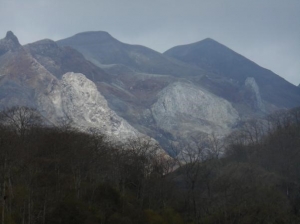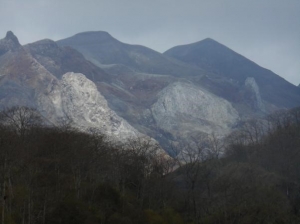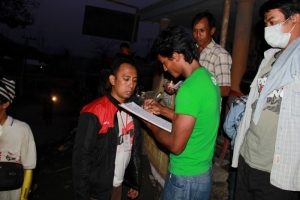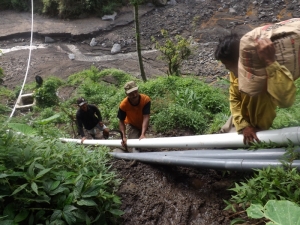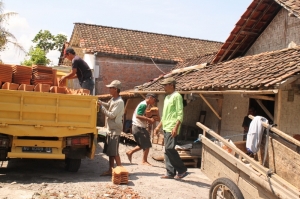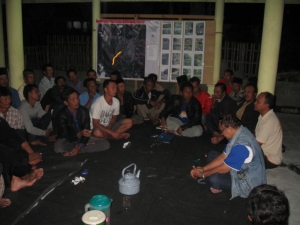[Mount Kelud a month after eruption]
A week after distributing logistical support, our team began entering the Recovery period. Ideally the assessment have been carried out 1-3 days after the eruption of Mount Kelud. The board of our team think about some interventions: logistics, repair the source of life for survivors such as: agriculture, livestock, water supply and roof of the house. But there was no data based on assessment and gap information from the government or another humanitarian agencies.
Along with the idea, our team narrowed discussion on an effective aid in accordance with needs assessment data. So that, the intervention based on 3 things: repair roofs of houses, repair roofs cages and water supply.
East Java provincial government stated to send 100 billion rupiah to repair survivors houses, schools, water and sanitation facilities. Repair facilities for livestock and agriculture has not been prioritized. Government is also committed to provide support for logistics of food for the next 3 months supplied in the Village Office. However, relief from the government change when arrived, because of bureaucratic factor, political and weakness of local government capacity. This condition make our team must verify data based on assessment. Verification involving village officials and residents to ensure that the materials really needed by residents and to avoid double relief. Residents who have not received aid from any parties been prioritized.
In terms of distribution process, there is information from the official of Villagge Pandansari. Start from 23/3/2014 all agencies are required to leave the village, until 3 weeks of legislative elections, due to quite period. This situation would disrupt the distribution process, data verification and process of repair of roofs, roof cages and distribution other materials. Our team plan: dropping material not at disaster site or in Village Hall. Or other alternative, Field Coordinator, volunteers, residents involving village officials, write official permission to local government and police.

During this time when there is assessment, residents feel disappointed because relief are not immediately come. As an example, assessment from government about livestock in Sub Villagge Pait, was never realized until 4 month. Many agencies are asking needs to residents, but there are not realization. After emergency response period, after military intervened roofs and water supply, there are still a lot of advanced work. Pipeline for Sub Villages just for the main line. Residents expected to continue by themselves.
Our team remains to establish coordination with residents when relief had not arrived. Another gap that need to complete: houses improvements, dredge volcanic ash about 50 cm and conducted a survey to residents who have not received aid in some sectors: roof of houses, water supply, livestock and agriculture. Gradually, distribution of relief from our team become concrete answer, that we not just take assessment. In Sub Villagge Pait and Ngramban, our team will continue the pipeline from reservoir provided by the government, to the nearest location or houses of residents.
In Sub Villagge Ngramban and Pait, Munjung also Kutut, the only bridge to access the Sub Villages was broken. This condition condition makes our team must be vigilant, especially the river is a lava flow. To reach 3 Sub Villages in Pandansari, vehicle must pass a river. So our team always cautious, but focused on the needs of residents.
When construction of pipeline from springs to the Sub Villages, residents sometimes feel bored. The reason is residents are quite busy working arrangement field or livestock. The other factors is rain which makes people refused to take the risk. Because the location is prone to landslides and floods lava. In addition, there were a series of local celebration that attention residents. Coordination, meetings and rescheduling with residents always at night. On the day work, residents need volunteer from our team to motivate people.
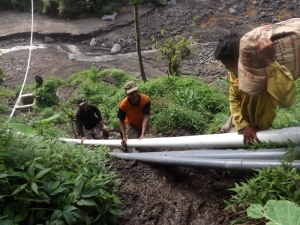
While construction of pipeline, residents feel difficult because remote location, near the river or cliff around 10 m deep. Location pipe on the brink of the river that is prone to landslides. Pipeline and material will be transported passing through the brink of cliff. According to residents, the installation process using emergency seat, attached a rope tied to body on a large tree, so that the installation by hanging cliff. Residents duties per group, thus reducing the workload. Location must be taken by motorbike that can reduce travel costs.
On the journey to top of Mount Kelud, there are so many materials of volcanic ash and rock that has accumulated. A large volcanic ash and rock lava fulfill on the north side that will lead to Pare and Kandangan. However in the southern side that will lead to Blitar. People around the lava flow is not yet received attention from the goverment, such as: the signs of the evacuation, a warning of lava and the warning signs at an early stage. It was happened on Wednesday, 17/4/2014, couple Muji-Sriani fall in flowing lava.
[caption id="attachment_314662" align="aligncenter" width="300" caption="Emergency bridge form bamboo"]
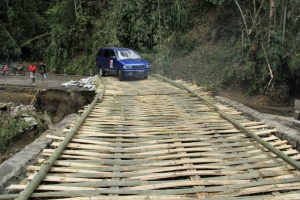
There is a bridges that were damaged, at this time residents only use emergency bridge of wood and bamboo being reared by their own. The bridge is very important as the only way to Villagge Ngramban. During this condition relation with livestock community and aid from outside just disturbed. Our team played a role campaigns to local governments or network. Field Coordinator attempts to encourage the Head of Village Ngramban to report the condition to Sub Region of Ngantang, but there is still no answer.
There are some difficulties about data of benefaciaries. Data from early assesment is still rough, still have possibility to change due to assistance from government or other agencies. Changes in material bring impact to increases budget. However, data changes and the availability of funds is not yet known. Special pipe does not match with the specification, price and amount of needed by residents. Jerry cans are not ready within a week. About pipeline installation, wire steel is not available in Ngantang or Wlingi.
Facing that condition, Managers, Field Coordinator and volunteers will verify the assessment data in accordance with beneficiaries criteria. The discussion of selection involving village officials and local residents. Team will communicate regarding use of funds effectively, verifies benefaciaries that really need aid and search the best price offers. Team will looking for the best price from supplier with specifications as required by residents. Team agreed to choose the best material price because of urgent needs of residents. The priority paid is tile roof because it is tied with the supplier agreement. While galvalum and tin roof payment can be communicated with suppliers.
Residents have received tile before, had to adjust that type of tile that will be accepted match with previously received from government. Tile types of Mantili requires strong roof truss. Residents whom get types of Mantili suggested get a new and strong roof truss and need to replaced their roof truss. Situation in the 4 Sub Villagge Pait, Kutut and Munjung and Ngramban still require some relief in such sectors: roof of houses, roof of cages, clean water and agriculture. But our team need to pay attention again what sector has not been provided by government or any party, focusing on assessment and give priority to most affected residents. After determining the focus of the intervention, our team needs to complete data assessment and mapping resources.
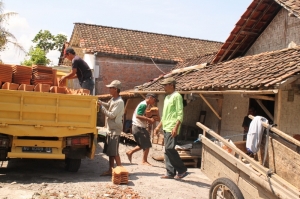
In process of tile installation, time agreed after people manage their livestock and working in the field. In Pare, there are 2 people who have not signed the acceptance of tile, prepared by Field Coordinator, but he has had a receipt based on the pre-prepared form. Residents adjust that the type of tile received from government with tile received from our team. If the tiles do not match, they replace with tile received from our team. There are some people whose names are not listed in the list of recipients, but asking for materials. Residents use familiar nicknames that do not comply with the applicant's name. Once clarified, it turns same. This is because when tile is distributed, coordinator call the familiar name. Beneficiary's signature on the form have the same with other benefaiciaries. So, team coordinated with the Head of Village to repair data. There is a special request for a family of the widows, the elderly and people who have difficulty installing itself to involve neighbors in installing tiles.
While construction of pipeline, there is tendency every Sub Villagges control or want to have the same springs. This situation could make another village did not get the water. This potentially raise a problem if utilization not well regulated by involving all Sub Villagges. But the local government or Head Village does not play a central role.
Our team always involving residents and volunteers whom know situation of residents. So, if there are any problems or suggestions regarding the distribution and installation, can be communicated involving residents, Field Coordinator and volunteers. Solution chosen should be solved with participation of residents. Furthermore, if they still need support, our team will try to support aid in accordance with assessment data. About using name does not match, the receipt of aid that has not received a receipt and distribution of aid is incompatible with the initial assessment, solved by taking with clear criteria. ID cards use for residents in accordance with the recipient's name listed. Every recipients who have received aid must sign a receipt.
About mutual assistance, installation of pipeline and reservoir, team set up plan with all residents so the activitis not disrupt people who are returning to work. So that residents can planned pipeline, but still can work to fulfill their everyday lives. In cases utilization of resources from various parties, such as water springs, our team facilitate meetings involving several Sub Villagger. Inter-village meetings will facilitate a dialogue that gives solutions. So that the utilization springs not be a problem in the future.
To find data of residents whom not received any relief, often debate with some people. Someone angry because has not get any aid. Problems arise in the recovery phase is a conflict of interests, needs and priorities. There is a certain conflict of interest, especially village authorities of local government in recovery process, make a long debate. They said that aid must through the goverment or village official. In fact, residents said that aid through the villages official do not come to beneficiaries. This condition causes the target time and the data is often changed. In other hand activities planned match with program planning. This situations open tolerance negotiations with interests of residents. The execution involving people always delays, as they taking care of their livestock or land. Team has been formally approached with local government or village official, coordination meeting at Villagge Hall, also personal communication with residents to provide that the aid based on assessment survey which also involve officials of local village. Volunteer in the field keep communication with village officials, residents and our team. If there is a change, always coordinated. For example, tin roof cuts in Pare and in Sub Village Pait, continued pipeline only from reservoir to a certain point in the village. In Sub Villagge Ngramban, it raises leader from residents, as Mr. Sukani push pipeline construction must be resolved, so that residents began to recover immediately.
The fundamental change in the emergency and recovery phases were changing needs. From the needs of food to shelter to other requirements such as housing and economic sustainability. In fact, fulfillment of these needs from emergency phase to recovery has not been completed by the goverment. This condition rise wide gap of the need. One side the food are completed, at the other side needs of house, jobs and overall have not yet been normal. This changing causes priority changed every time. Its difficult for residents involve in program activities have been planned. If program forced participation of residents, the implementation program will slow and not match with duration that has been planned.
In Pare, residents in disaster prone areas feel anxious because there is local wisdoms, that within 35 days after the eruption (Selapanan), there is usually a flood of lava. So that, these issues disrupted the activities of people in distribution and installation materials, because people need to evacuate to the safe location. Our team tried to rhythm of residents activities and keep communication as planned before.
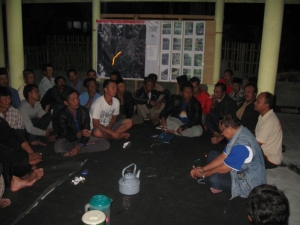
Finally, as happens in various of disasters, including the eruption of Kelud in February 2014, the disaster can be predicted. But the government less anticipating. The government is still stuttering and not ready to anticipate the impact of disasters. Bureaucratic constraints, not involving residents, handling with certain priority, cause apathy of residents. Some examples: refuge area in an unsafe location, with no logistics, the lack of warning sign or evacuation routes and implementation of programs without discussion with residents. Residents have made exceptional acts according to their ability. But the government should do with the best ability, as mandated by Disaster Management Law No. 24 / 2007. Action needs is how to prevent avoidable casualties. Therefore the government needs to plan society in disaster prone areas, such as: assessment of disaster risks, mapping of vulnerable areas, early warning tools, preparation of reserve fund, insurance, prepare human resources and other resources.
Baca konten-konten menarik Kompasiana langsung dari smartphone kamu. Follow channel WhatsApp Kompasiana sekarang di sini: https://whatsapp.com/channel/0029VaYjYaL4Spk7WflFYJ2H




